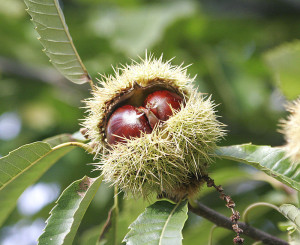Castanea sativa, or sweet chestnut, is a species of flowering plant in the family Fagaceae, native to Europe and Asia Minor, and widely cultivated throughout the temperate world. A substantial, long-lived deciduous tree, it produces an edible seed, the chestnut, which has been used in cooking since ancient times.
Contents
Uses
The species is widely cultivated for its edible seeds (also called nuts) and for its wood. As early as Roman times, it was introduced into more northerly regions, and later was also cultivated in monastery gardens by monks. Today, centuries-old specimens may be found in Great Britain and the whole of central, western and southern Europe.
The tree was a popular choice for landscaping in England, particularly in the 18th and 19th centuries. C. sativa was probably introduced to the region during the Roman occupation, and many ancient examples are recorded. More recently, the tree has been planted as a street tree in England, and examples can be seen particularly in the London Borough of Islington.
A tree grown from seed may take 20 years or more before it bears fruits, but a grafted cultivar such as ‘Marron de Lyon’ or ‘Paragon’ may start production within five years of being planted. Both cultivars bear fruits with a single large kernel, rather than the usual two to four smaller kernels.
The ornamental cultivar C. sativa ‘Albomarginata’ has gained the Royal Horticultural Society’s Award of Garden Merit.
Sweet chestnut has been listed as one of the 38 substances used to prepare Bach flower remedies, a kind of alternative medicine promoted for its effect on health. However according to Cancer Research UK, “there is no scientific evidence to prove that flower remedies can control, cure or prevent any type of disease, including cancer”.
Benefits
For therapeutic purposes, the harvested parts of the edible chestnut are the bark, flowers, leaves and seeds.
The fruits have a similar composition to the wheat and are a source of carbohydrates, phosphorus, lecithin and vitamin C. They also contain protides, fat, calcium, iron, magnesium, manganese, zinc, potassium and their caloric value is 200 calories per 100 g.
The gathering of the edible chestnuts happens in late September and early November.
Chestnut puree is one of the few products which, heat processed, still maintain in a large amount the vitamins found in the fresh fruit.
Cautions
Please check with your homeopathist.
Interactions
None are recorded.
Other names
chinquapin and chinkapin
References
Source: Wikipedia, https://en.wikipedia.org/wiki/Castanea_sativa#Uses
Seedguides, http://www.seedguides.info/chestnut/

